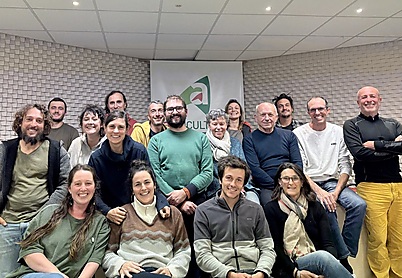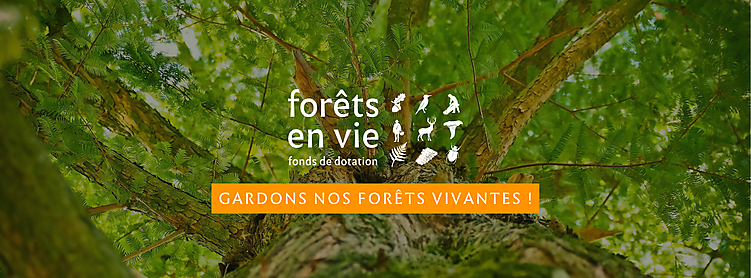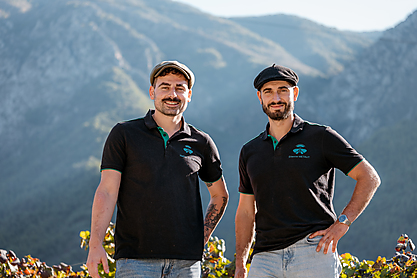Transformer un champ de monoculture en une forêt nourricière
par
Franziska Kern et Benoit Trouvé

Don avec contrepartie
Plantation de nombreuses variétés d'arbres afin de créer la première strate d'un écosystème autosuffisant et diversifié.
Bretagne
Landivisiau, France
41
Contributeurs
3 190 €
Projet financé !
Le 7 décembre 2023
En soutenant ce projet, vous oeuvrez pour :
English version
Together, lets transform a monoculture field into an abundant and diverse food forest

Executive Summary
As the headline states, we want to establish an abundant and diverse food forest! A food forest mimics natural processes found in native forests, integrating nature and food production. They consist of several layers, trees, shrubs, groundcover, climbers, etc. Instead of planting only one species, a self-sustaining ecosystem is created. But, Food forests need time to establish! Therefore, the first step is to plant the canopy layer with all the trees that need the longest to develop. This is where YOU come into the game. We need your help with purchasing all the various trees. Further, we need certain materials like wood chips, sticks and cardboard for planting and protecting the trees. We have chosen French nurseries; our priority lies on small and local nurseries that respect nature as we do. As we want to create a biodiverse environment, we will be planting 30 different types of trees and various varieties within each species. And this is only the first layer of our food forest! Over time, the objective will be to supplement the different strata with suitable species.
We are grateful for your contribution to our project. Together we can create a world where local, healthy and durable food is accessible to everyone.
Counterparties (Website can only display the buttons in French)
10 Euros or more
Contributors wall
Your name (or nickname) will appear on the contributor's wall dedicated to the supporters who made this project possible. Thank you!
20 Euros or more
Name a tree!
In addition to "Contributors wall", you will be able to choose the name of your tree and add a message of your choice. It will be readable by everyone during open days and events. Thank you so much!
30 Euros or more
Bay leaves
In addition to “Name a Tree” and “Contributors wall”, you will get a bag of bay leaves that are harvested from us with love. A big thank you!
50 Euros or more
Homemade Elderberry Sirup
In addition to “Name a Tree” and “Contributors wall”, you will get a bottle of homemade elderberry sirup. A huge thank you!
100 Euros or more
Colorful Fruit Basket
In addition to “Name a Tree” and “Contributors wall”, once the trees start producing you will receive a fruit basket with various and colorful fruits. 😊 We can't thank you enough!
120 Euros or more
Food Forest tour
In addition to “Name a Tree” and “Contributors wall”, you will be invited for a Food Forest tour where we will show you around and explain everything about the project. Then we will have a picnic with local food in the field. All the thanks in the world are not enough to express our gratitude.
The website only offers payments via credit card, if this payment method is not possible for you, there is also the possibility to transfer the money. Please indicate your choice of counterparty and email adress in the subject line so that we can get back to you about receiving the counterparty and add you to the list of contributors.
Name: Franziska Kern
IBAN: FR74 2004 1010 1311 9651 8K03 488
For any further questions, do not hesitate to contact us via the following email adress: Franziskakern1@gmx.at
Hello everyone,

I am Franziska, 24 years, from Austria. And I want to tell you a bit about the story that led me to write these lines today. From when I was 15, I knew I wanted to do something with my life that would make this world a better place. I continued to do a bachelor’s degree in environmental sciences, which made me see our actions' impact on the planet. I saw how much is going wrong in modern agriculture leading to biodiversity loss, erosion, greenhouse gas emissions, and soil and groundwater pollution, but also to inequalities across the value chain and impacts on public health.
I volunteered in a reforestation project where I met some very lovely people that first introduced me to the amazing world of a very different kind of agriculture that I knew of. I felt like I finally found my place, my thing that I am so very passionate about. Luckily, I had the chance to do a major in sustainable agriculture during my studies. This led me further onto the path of agroecology and alternative food systems. In fact, problems caused by conventional agriculture can be addressed by alternative food systems in various ways. They have the potential to regulate and support the environment, produce healthy food and sufficient livelihoods, and provide sociocultural services such as spaces for recreation, education, and community building.



Somehow, I passed the virus onto my partner Benoit, 25 from France. We started to read literature and books about these systems, did the Food Forestry course of Martin Crawford (a renowned Food Forester with 30 years of experience), visited various farms and watched documentaries and interviews.

Now, we want to be part of a positive change rather than staying pessimistic. Our dream is the following:
We dream of a world where everyone can access local and healthy food. A world with short value chains, meaning direct contact between consumer and producer, reconnecting them to where their food comes from. A world where people value their food so that waste is minimised. We believe that good food lies at the heart of the solution! Good in terms of taste and freshness, of course, but also in how it is produced: sustainably, with the health of the local environment and communities in mind.
We are convinced that food forests are part of moving towards this vision (part of the solution). But what are food forests?
Food forests
Food forests are a form of agroforestry commonly practised in indigenous and traditional production systems in the tropics and subtropics (called home gardens) and go back 12000 years. Food forests mimic natural processes found in native forests, integrating nature and food production. They consist of several layers, trees, shrubs, groundcover, climbers, etc. Instead of one species, a self-sustaining ecosystem is created. You go and see okay nature is doing it like this – how can I replicate that?

This system uses mainly perennial plants, all planted to maximise positive interactions between species and minimise negative ones as much as possible. This makes this system more resilient to climate change, it increases biodiversity, decreases erosions, helps to build up a healthy soil where soil organisms can thrive – which in turn creates a whole ecosystem that makes it more difficult for pests to establish. The system is designed to be circular, meaning that external inputs are minimised and all resources in the system are used. Waste is not seen as waste but rather as a valuable resource for another process. The food forest will have multiple fruit trees (Apples, pears, peaches, plums, cherries, Khaki, Quince, Fig, Mulbery, Apricot, Medlar,…), nut trees (chestnut, almonds, walnuts, hazelnuts..), berries (raspberry, strawberry, thornless bramble, cassis, loganberry, autumn olive…), herbs and medicinal herbs (basil, oregano, mint, coriander, parsley, thyme, wild garlic,..), perennial vegetables (leek, cabbage, broccoli, chayote, sweet peas..), climbers (grapes, kiwis, …) but also more unknown species, as well as trees for salad leaves, herbs and spices and support species for nitrogen fixing and biodiversity. The focus will be on local and resistant varieties.
But, Food forests need time to establish! Therefore, the first step is to plant the canopy layer with all the trees that need the longest to develop. This is where YOU come into the game. We need your help with buying all the various trees.

At the beginning of the year, we were able to acquire a beautiful piece of agricultural land, which is surrounded by a line of trees. The first phase of our project consists of planting 200 trees on about 1 hectare of land.


Long term plans of the project
The products grown on the farm will be sold via community supported agriculture. This farming model is built on fairness and transparency for both the farmer and the consumer. It connects producers and consumers within the food system. Traditionally, a consumer buys a share of a farm up-front, which provides financial security to the farmer for that season. In return, the consumer receives a regular box of fresh produce and gets involved in the farms operation and production in various ways. Relationships are cultivated through weekly newsletters and open events on the farm. The consumer knows precisely how their food is produced and is updated on relevant events at the farm. Within this model, Solidarity payment will be implemented. Solidarity payment is based on profit with values. Consumers are not paying for the product they are receiving but rather for the work needed to produce the food. So in detail, that means all work done on the farm is transparently presented. Then it is calculated how much time (on average) was needed to produce this and then based on that consumers can decide which hourly wage they want to give. This allows people with a higher income to pay more so that a member of the community with a low income also has access to high quality and local food, while the farmer receives a fair wage. Overall, the goal is that the farmer can gain a fair wage while including people with all incomes. It's a trust-based economy. In the Netherlands, municipalities started to give out subsidies for this system to make it even more accessible for people with low income.
Another important aspect of the farm will be sharing knowledge. We want to invite people to come and see what we are doing and why and showing them a sustainable food system aligned with nature is possible. Workshops to teach how people can implement this on their own are planned within this concept. Further, we want to provide an outdoor educational experience for children, a fun space to experience and learn about nature and sustainable food production.
In the future, we can also see the possibility of conducting research on the farm. Currently, industrial agriculture is heavily researched, while more scientific knowledge on alternative food systems is needed. We would like to contribute to that and offer internships and thesis projects.
What will the collection be used for?
The collection will be used to buy the trees that will be planted on the land. Further, we need certain materials for planting and protecting the trees. We have chosen French nurseries, our priority lies on small and local nurseries that respect nature as we do.
As we want to create a biodiverse environment, we will be planting 30 different types of trees and various varieties within each species. And this is only the first layer of our food forest! Over time, the objective will be to supplement the different strata with suitable species. In the following you can see an overview of the trees we plan to purchase:
| Trees | Varieties | Quantitz | Price [€] |
| Quince | Wranja, Portugal, Leskovacz Aromatnaya | 4 | 76 |
| Fig | Brown Turkey, Noire De Bellone, Rouge De Bordeux | 3 | 48 |
| Apple | Reinette d’Armorique, Belle De Boskoop, Germaine De Braspart, Astrakan Rouge, Reinette Du Mans, Topaz, Ariane | 7 | 140 |
| Medlar | Geant D’Evreinof, D’Allemagne, Belle De Grand Lieu, Apyrena | 4 | 76 |
| Apricot | D'anjou, Bergeron, Luizet, Précoce de saumur | 4 | 88 |
| Cherry | Bigarreau Blanc, Burlat, Géant D'hedelfingen, Napoléon, Summit | 5 | 100 |
| Plum | Mirabelle De Nancy, Golden Japan, Reine Claude D‘Oullins, Reine Claude Doree, Reine Claude Verte Bonne, Reine Claude De Bavay, Stanley | 7 | 133 |
| Peach | Benedicte, Amsden, Reine Des Verges, nectared 6, Avalon Pride | 5 | 100 |
| Pear | Stark crimson, Précoce Du Trevoux, Soldat Loboureur, Sœur Gregoire, comtesse de paris | 5 | 85 |
| Kaki | Tone Waze, Rojo Brillante, Muscat, Meader Virginia | 4 | 88 |
| Nashi | Tsu Li, Kosui, | 2 | 40 |
| Chestnut | Pecoce Migoule, Bouche De Betizac, Maridone | 3 | 87 |
| Almond | Ai, Robijn, Texas, Ferragnes | 4 | 88 |
| Pepper tree | Timut, Sichuan | 5 | 63 |
| Bayberry | Vulgaris, Red Tear, Koreana | 8 | 96 |
| Strawberry tree | Fleur Blanche, Atlantic | 2 | 45 |
| Sea buckthorn | Leikora, Masculi | 11 | 109.3 |
| Mandarin | Satsuma | 2 | 70 |
| Lemon | Meyer | 2 | 70 |
| Pawpaw | 3 | 225 | |
| Dogwood | 2 | 26 | |
| Hawthorn | 2 | 7.5 | |
| Silverbell tree | 1 | 32.5 | |
| Mulberry | 4 | 168 | |
| Walnut | Fernor, Perigord, Baliveau | 3 | 204 |
| Elaeagnus | Umbellata, ebbingei, angustifolia, multiflora | 62 | 313 |
| Judas tree | 7 | 220 | |
| Alder | 10 | 29 | |
| Siberian pea tree | 14 | 55 | |
| Common broom | 11 | 140 | |
| Sum | 206 | 3022 |
| Materials | Prix total [€] |
| Bark mulch | 480 |
| Cardboard | 360 |
| Mycorrizha | 75 |
| Sum | 915 |
Sum total: 3022 Euro + 915 = 3937 €
If your contributions exceed 100% of this objective, we will use them to finance the making of a hedge which increases biodiversity and provides wind protection for our trees.
We are grateful for your contribution to our project. Together we can create a world where a local, healthy and durable food is accessible for everyone.
For contributions by check, here is my mailing address:
11 lieu dit le Drennec, 29400 Landivisiau
Don’t forget to specify your last name, first name and email address. This way, you will be added to the list of contributors.

Contreparties
Pour 10 euros ou plus
Mur des contributeurs
Votre nom (ou votre pseudo) apparaîtra sur le mur des contributeurs dédié aux personnes qui ont rendu ce projet possible. Merci !
Choisie 3 fois
Pour 20 euros ou plus
Donne un nom à un arbre
En plus de la récompense "Mur des contributeurs", vous pourrez choisir le nom de votre arbre et ajouter un message de votre choix. Il sera lisible par tous lors des journées portes ouvertes et des événements. Un grand merci à vous !
Choisie 8 fois
Pour 30 euros ou plus
Feuille de laurier du jardin
En plus des récompenses "Nommez un arbre" et "Mur des contributeurs", vous recevrez un sachet de feuilles de laurier que nous récoltons avec amour. Un grand merci !
Disponibilité
février 2024
Livraison
Nationale
Choisie 3 fois
Coup de
Pour 50 euros ou plus
Délicieux sirop de sureau maison
En plus des récompenses "Nommez un arbre" et "Mur des contributeurs", vous recevrez une bouteille de sirop de sureau fait maison. Un grand merci !
Disponibilité
juillet 2024
Livraison
Locale
Choisie 6 fois
Pour 80 euros ou plus
Corbeille de fruits colorée
En plus des récompenses "Nommez un arbre" et "Mur des contributeurs", une fois que les arbres commenceront à produire, vous recevrez une corbeille de fruits avec des fruits variés et colorés 😊 Nous ne vous remercierons jamais assez !
Quantité restante
8
Disponibilité
août 2025
Livraison
À retirer sur place
Choisie 2 fois
Pour 120 euros ou plus
Visite de la forêt nourricière
En plus des récompenses "Nommez un arbre" et "Mur des contributeurs", vous serez invités à la forêt nourricière. Nous vous ferons visiter les lieux et vous expliquerons tout ce qui concerne le projet. Ensuite, nous ferons un pique-nique avec des produits locaux dans le champ. Tous les remerciements du monde ne sont pas suffisant pour exprimer notre gratitude.
Quantité restante
11
Choisie 4 fois
Don libre
1
Sélectionnez un projet
en fonction de la thématique, de sa localisation ou des contreparties.
2
Choisissez une contrepartie
et ajustez si vous le souhaitez le montant de votre contribution.
3
Recevez vos produits
ou profitez des séjours et expériences que vous avez choisis.
4
Partagez votre expérience
sur les réseaux sociaux @miimosa_fr pour continuer de soutenir le projet et son porteur.

.png)



